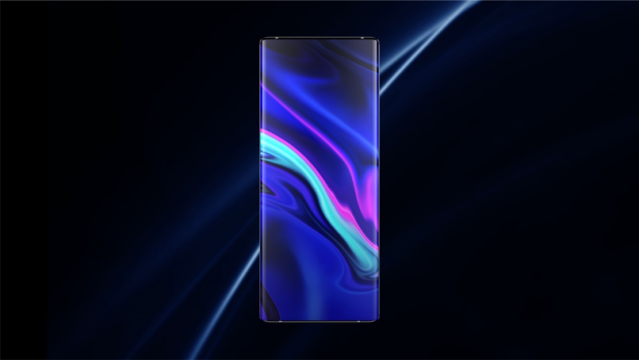Last year, Vivo’s fancy Apex 2019 concept showed us what a phone without ports might look like. But now, Vivo has returned with an even more fantastical concept device featuring a number of potentially major innovations throughout the device.
Starting in front, the Apex 2020 sports a 6.45-inch display with curved glass that bends 120-degrees around the edge of the phone, which completely eliminates the left and right bezels you’d get on a normal phone. Vivo also says that by changing the way the edge of the screen meets the phone’s metal frame in back, the Apex 2020 delivers an unprecedented “ultimate” in-hand feel.
Now because the Apex 2020’s sides are all glass, that means there’s no room for physical buttons, and in fact, there’s no external ports or large openings across the entire device. When it comes to unlocking the phone or adjusting volume, Vivo opted for pressure-sensitive virtual buttons instead. And for recharging the device, your only option is wireless charging at up to 60-watts, which is a huge jump up from the 15-watt wireless charging you get on a lot of today’s high-end phones.
But perhaps one of the most impressive innovations on the Apex 2020 is something you won’t see: a hole or a notch for a front-facing camera. That’s because Vivo did what Samsung, Huawei, and others have been trying to create for a while and put the Apex 2020’s front-facing camera underneath its display.
[referenced url=” thumb=” title=” excerpt=”]
Normally, putting a camera below a display doesn’t work because even when its screen is turned off, the layer of pixels and circuits in a phone’s display reduces the amount of incoming light so much that photos end up looking dark and blurry. So for the Apex 2020, Vivo engineered a new pixel and circuit layout and combined that with an algorithm that decreases optical interference, allowing six times more light to reach the front-facing camera’s sensor. And without a notch or punch hole, you also get a true all-screen device without any distractions.
Meanwhile, for audio, the Apex 2020 comes with Screen SoundCasting tech that vibrates the phone’s display to output sound. This is something we’ve seen before on phones like the LG G8 and others, so it’s not really a massive breakthrough, but I do appreciate how this feature fits in with the rest of the phone.
And in back, the Apex 2020’s camera boasts two significant upgrades: a continuous optical zoom and what Vivo is calling a gimbal-stabilised main camera. On practically every device with an optical zoom, phone makers use multiple lenses with fixed focal lengths and software to create the illusion that you are zooming in seamlessly the closer in you go.
However, on the Apex 2020, Vivo created a special continuous optical zoom system with four lens elements that function more like a zoom lens on a traditional DSLR or mirrorless camera. And despite measuring just 6.2mm thick, Vivo says its zoom system delivers 5x to 7.5x worth of magnification.
As for the Apex 2020’s gimbal-stabilised main camera, Vivo says it combines traditional OIS with two additional axes of stabilisation so that it can adjust for “front-back” and “left-right inclined” movements. (Traditional OIS on phones typically only handles stabilisation in the X and Y directions.) Vivo says this setup was inspired by the biomechanics of a chameleon’s eye, which is able to rotate around quickly to better track fast-moving objects.
On top of all this, the Apex 2020 also comes with a couple of other nifty upgrades thanks to a video feature that lets you remove distracting objects from the background of videos as if you were shooting on a green screen. And like we’ve seen on the Galaxy Note 10, LG V60, and others, the Apex 2020 also boasts “voice tracking autofocus” that lets you isolate people’s voices so that they are easier to hear.
However, as neat as all this sounds, it’s important to remember that the Apex 2020 is still a concept device. Vivo has only provided a limited selection of specs detailing things like the Apex 2020’s Snapdragon 865 chip, 12GB of RAM, 256GB of storage, and that it runs Android 10, but that’s about it. More importantly, Vivo hasn’t mentioned anything regarding price or availability, so it’s unlikely that this phone ever goes on sale.
Still, a bunch of the new features that Vivo put on the Apex 2020 are really interesting, so here’s hoping Vivo can figure out a way to put all this tech into something we can actually buy.
